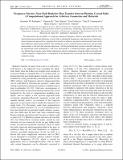Frequency-Selective Near-Field Radiative Heat Transfer between Photonic Crystal Slabs: A Computational Approach for Arbitrary Geometries and Materials
Author(s)
Rodriguez-Wong, Alejandro; Ilic, Ognjen; Bermel, Peter A.; Soljacic, Marin; Celanovic, Ivan L.; Joannopoulos, John; Johnson, Steven G; ... Show more Show less
DownloadRodriguez-2011-Frequency-Selective Near-Field Radiative.pdf (516.0Kb)
PUBLISHER_POLICY
Publisher Policy
Article is made available in accordance with the publisher's policy and may be subject to US copyright law. Please refer to the publisher's site for terms of use.
Terms of use
Metadata
Show full item recordAbstract
We demonstrate the possibility of achieving enhanced frequency-selective near-field radiative heat transfer between patterned (photonic-crystal) slabs at designable frequencies and separations, exploiting a general numerical approach for computing heat transfer in arbitrary geometries and materials based on the finite-difference time-domain method. Our simulations reveal a tradeoff between selectivity and near-field enhancement as the slab-slab separation decreases, with the patterned heat transfer eventually reducing to the unpatterned result multiplied by a fill factor (described by a standard proximity approximation). We also find that heat transfer can be further enhanced at selective frequencies when the slabs are brought into a glide-symmetric configuration, a consequence of the degeneracies associated with the nonsymmorphic symmetry group.
Date issued
2011-09Department
Massachusetts Institute of Technology. Institute for Soldier Nanotechnologies; Massachusetts Institute of Technology. Department of Mathematics; Massachusetts Institute of Technology. Department of PhysicsJournal
Physical Review Letters
Publisher
American Physical Society (APS)
Citation
Rodriguez, Alejandro et al. “Frequency-Selective Near-Field Radiative Heat Transfer Between Photonic Crystal Slabs: A Computational Approach for Arbitrary Geometries and Materials.” Physical Review Letters 107.11 (2011): n. pag. Web. 9 Feb. 2012. © 2011 American Physical Society
Version: Final published version
ISSN
0031-9007
1079-7114